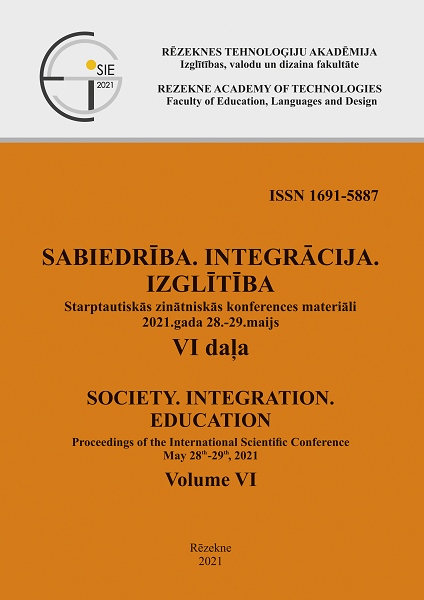WHY DID THEY NEED TO COME NOW? COVID-19 CRISIS STRAINS RELATIONSHIPS WITH RETURNING AND VISITING COMPATRIOTS
DOI:
https://doi.org/10.17770/sie2021vol6.6266Keywords:
return migration, Covid-19, public attitudes, educationAbstract
One of the first areas severely hit by the Covid-19 pandemic was international travel. In March/April, with commercial flights coming to a near halt, the governments were struggling to help their stranded citizens to return home. Extra flights and ferry trips were organised, and the opportunity to return was used by many emigrants worried about the uncertainty and the possible future development of the pandemic. This paper containing both data collected through survey and in-depth interviews with people aged 50+ in Latvia, is the first to explore the reactions of the society to repatriation policy implemented by the government of Latvia, and to explore how the Covid-19 situation has affected the attitudes towards return migrants in general. Importantly, it demonstrates how education moderates these attitudes. The results show that most of the population consider returning migrants as a significant source of infections, and many had doubts if they follow self-isolation and other rules responsibly. Those with the higher education were in general more supportive of the repatriation policy demonstrating the importance of education and explaining difficult decisions in order to reduce tension and fear.
References
Esses, V. M., Medianu, S., & Lawson, A. S. (2013). Uncertainty, threat, and the role of the media in promoting the dehumanization of immigrants and refugees. Journal of Social Issues, 69(3), 518-536. DOI: https://doi.org/10.1111/josi.12027
Faulkner, J., Schaller, M., Park, J. H., & Duncan, L. A. (2004). Evolved disease-avoidance mechanisms and contemporary xenophobic attitudes. Group Processes & Intergroup Relations, 7(4), 333-353. DOI: https://doi.org/10.1177/1368430204046142
Haslam, N., & Holland, E. (2012). Attitudes towards asylum seekers: The Australian experience. In D. Bretherton & N.Balvin (Eds.) Peace psychology in Australia (107-120). Boston, MA: Springer.
Hazans, M. (2020). Diasporas apjoma novērtējums. Rīga: LU Diasporas un migrācijas pētījumu centrs. Retrieved from: https://www.diaspora.lu.lv/fileadmin/user_upload/lu_portal/projekti/diaspora/petijumi/Diasporas_apjoma_novertejums_-_Zinojums.pdf
Huang, J., & Liu, R. (2020). Xenophobia in America in the Age of Coronavirus and Beyond. Journal of Vascular and Interventional Radiology, 31(7), 1187-1188. DOI: https://doi.org/10.1016/j.jvir.2020.04.020
Norredam, M., Agyemang, C., Hoejbjerg Hansen, O. K., Petersen, J. H., Byberg, S., Krasnik, A., & Kunst, A. E. (2014). Duration of residence and disease occurrence among refugees and family reunited immigrants: test of the ‘healthy migrant effect’hypothesis. Tropical Medicine & International Health, 19(8), 958-967. DOI: https://doi.org/10.1111/tmi.12340
Lillebaek, T., Andersen, Å. B., Dirksen, A., Smith, E., Skovgaard, L. T., & Kok-Jensen, A. (2002). Persistent high incidence of tuberculosis in immigrants in a low-incidence country. Emerging infectious diseases, 8(7), 679. DOI: 10.3201/eid0807.010482
Mieriņa, I., & Koroļeva, I. (2015). Support for far right ideology and anti‐migrant attitudes among youth in Europe: A comparative analysis. The Sociological Review, 63, 183-205. DOI: https://doi.org/10.1111/1467-954X.12268
Mieriņa, I., Koroļeva, I., Grosa, D. & Jansone, R. Latviešu valoda diaspora: situācijas izpēte. Rīga: LU Filozofijas un socioloģijas institūts.
Puschmann, P., Donrovich, R., & Matthijs, K. (2017). Salmon bias or red herring? Human Nature, 28(4), 481-499. DOI: https://doi.org/10.1007/s12110-017-9303-1
Spallek, J., Zeeb, H., & Razum, O. (2011). What do we have to know from migrants' past exposures to understand their health status? a life course approach. Emerging themes in epidemiology, 8(1), 1-8. DOI: https://doi.org/10.1186/1742-7622-8-6
Sunpuwan, M., & Niyomsilpa, S. (2012). Perception and misperception: Thai public opinions on refugees and migrants from Myanmar. Journal of Population and Social Studies [JPSS], 21(1), 47-58. Retrieved from https://so03.tci-thaijo.org/index.php/jpss/article/view/84512
Vārna, I. (2020). Covid-19 krīze: lielā pieprasījuma dēļ izsludināti papildu repatriācijas reisi. Retrieved from https://skaties.lv/zinas/latvija/covid-19-krize-liela-pieprasijuma-del-izsludinati-papildu-repatriacijas-reisi/
White, A. I. (2020). Historical linkages: epidemic threat, economic risk, and xenophobia. The Lancet, 395(10232), 1250-1251. DOI: https://doi.org/10.1016/S0140-6736(20)30737-6






